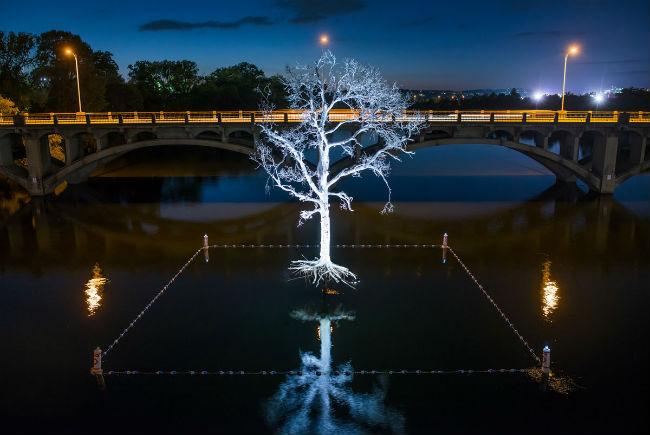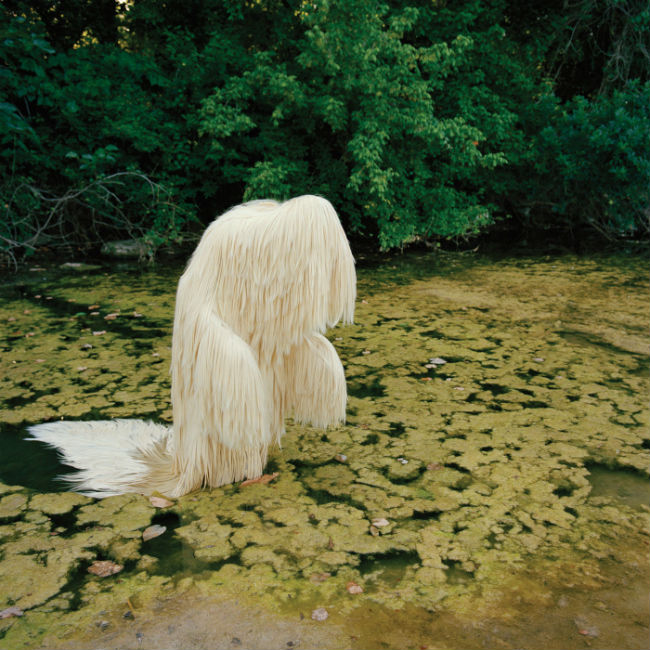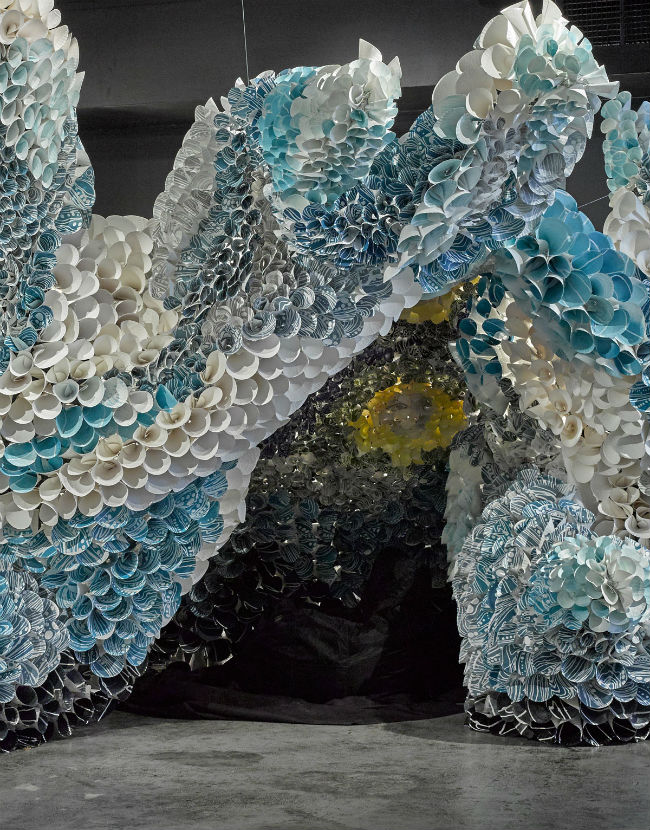What It Takes To Be A Working Woman

THIRST, a temporary outdoor installation featuring a 4,000-pound, 38-foot tall tree placed on Lady Bird Lake in Austin, Texas, 2013. To create the piece, Women and Their Work invited visual artist Beili Liu, Emily Little and Norma Yancey (architecture), and Cassie Bergstrom (landscape architecture) to collaborate. THIRST memorializes the loss of the over 300 million trees that died in recent Texas droughts, and acknowledges the devastating impact that changes in weather patterns have had on Austin. It also sounded as a call to action for conservation and sustainability. Photo by Tod Grubbs, Bee Creek Photography
As a grant-making agency, the NEA gets to make a lot of “happy calls.” These are when our staff gets to telephone applicants and let them know that their project has been approved for funding, and that they are officially an NEA grantee.
Just as sweet a day is when we get to spread this same news to the world at large. Today, the National Endowment for the Arts kicked off its first round of FY 2016 funding by announcing $27.7 million to support 1,126 projects in 49 states plus American Samoa, the District of Columbia, and Guam. One of these awards went to the Austin-based Women and Their Work, which seeks to advance the careers and talents of female artists creating contemporary art in Texas. This grant, which will support a series of solo exhibitions for emerging women artists, is hardly the organization’s first. In fact, in 1980, they became the first visual arts organization in Texas to receive NEA funding.
Ahead of the grant announcement, we spoke with Women and Their Work Executive Director Chris Cowden about the challenges of being a female artist, what progress she has seen, and why so many people find contemporary art so bewildering.
NEA: What was the original impetus for forming Women and Their Work?
CHRIS COWDEN: It was of a historical moment in the mid-70s. There was the rise of the alternative space movement. Before that period, mostly white men were dominant in every single field. In the mid- to late-70s, organizations started to pop up all over the country that were organized and run by people of color, women, gay, taking their fate in their own hands and creating organizations so that they, as a group, would not be locked out of any opportunities. We were part of that strong national movement.
NEA: Women and Their Work was founded in 1978. What were the challenges of being a woman in the arts at that time, and how have those challenges evolved?
COWDEN: I think there was a lot of esprit de corps, a lot of excitement. It was a positive thing. An organization here called Mexic-Arte was founded, and Black Arts Alliance, so people became masters of their fate. They controlled their destiny in some ways. So there were barriers coming down, and there was recognition of this and recognition of that, and a first here and a first there, and there was a great deal of exuberance.
At our 30th anniversary in 2008, we had this symposium. We were sitting in the office discussing how we would celebrate this big event, so got to looking at how many women have been in group shows in Texas? How many solo exhibitions in the major museums in the country? And the statistics in 2008 were not good. We were kind of flabbergasted. In the early days, Mary Boone was the bane of everyone's existence because she was a famous woman gallery owner all through the 80s and 90s, and she went on record saying that women didn't sell for as much, so why should she take a pay cut? Why should she show women? In this article that Hyperallergic wrote, she is up to 17 percent women. They thought that was a good thing. But really? It just didn't seem like such a cause for celebration. So things have changed in big ways, but in some ways, things haven't changed as much as we thought.

613 Silky Straight in Swamp by Susi Brister. Archival pigment print on Hahnemuhle photo rag. 44 " x 44". 2013. In lushly colored photographs, Susi Brister depicts anonymous figures covered in densely textured and patterned textiles inserted into landscapes as mysterious organic forms. Her work suggests magical narratives where creatures emerge from their habitats and strange figures mimic the landscape playing with notions of natural versus artificial. Both humorous and melancholy, these images emphasize the gap be tween the natural world and its synthetic imitations.
NEA: What signs of hope do you see, if any?
COWDEN: There are women that are succeeding. Like Kathryn Bigelow won an Academy Award [for directing The Hurt Locker]. She was the first, and maybe it's going to be 30 years before there’s another one. When the Sony hack happened, all those actresses were just flabbergasted at what they didn't get paid. I think you just have to hold people's feet to the fire, keep pointing it out, keep looking at it, keep being aware that it has to be emphasized that women need to be at the table, and their work has to be seen. Because that was the whole problem before. It wasn't that they didn't make anything; it just wasn't seen.
There was something just this morning on NPR about Hollywood Weekly. This woman started publishing the top 100 women in Hollywood, and she discovered that people would start rushing her and talking people up. She realized that a lot of it was negative, because if they were number 30, then they had to get to number 25, and everyone else was a threat. So she started this year not to rank them—people will just be in or out. But that's an interesting twist on achievement, and how to further the achievement of women, because she felt like it was self-destructive.
NEA: That's a good point, that the competition amongst women…
COWDEN: …is fierce, because there's kind of a perceived quota. But if we can be more collaborative and work together, then everyone can rise.
NEA: What kind of an environment does Women and Their Work hope to foster?
COWDEN: We've been really lucky at emphasizing the artist, who is a woman, as opposed to a woman artist. We focus on artists creating new work, taking their work to the next level, taking chances, being ambitious. I think that's helped artists and I think that's helped us. We've done well, and have had some recognition for that.
NEA: Since you've been involved with the organization, how have you seen the arts infrastructure in Texas change?
COWDEN: We really had nowhere to go but up. Texas is the third-largest state of residence for artists, but it ranks 48th in support for artists. For many years, across the state there were not really strong museums, and that has really changed in the last 15 years. The Dallas Museum, the McNeil Museum, the Houston Museum of Fine Arts is considered on of the top five museums in the country. So those have been great steps forward. But in Austin, we had a strong music scene, but even now there's hardly any place in town that a dancer can present on a properly sprung floor. We have a couple of theaters, but they're packed of course, so that's a big need.
You need an ecosystem. You need strong museums, you need strong artists, you need critics, you need collectors, and all that needs to be in synch and growing together. We didn't have some of that for years, and now we do. I think there's a lot more recognition of the importance of art, and some of that too is just people coming in. I think we're a more diverse and cosmopolitan population than we were 20 years ago.
NEA: I know part of the mission of Women and Their Work is to demystify contemporary art. So this is a two-part question: One, why do people find contemporary art so intimidating, and two, how do you hope to change that?
COWDEN: One, it's not taught in school. You have to take geometry—I've never used geometry since I left tenth grade. It's not required in school, so from the get go, it's seen as peripheral—all arts are. When you think about America as opposed to Europe, there is a glorious piece of art on many street corners all over Europe. And in the U.S., you have to go into a museum to see it. So people aren't exposed to it, and it's seen as kind of rarified.
But the thing that surprises me the most [is that] some people can be quite belligerent. I think some of that's insecurity, or some kind of discomfort with contemporary art. Often the comment is "I could do it," or "What does it mean? I don't understand." On the one hand it's seen as incredibly useless and trivial and elite, but then it's often the first thing that's attacked if any kind of object is considered pornographic or blasphemous. People become more upset about a work of art than almost anything. So it's curious.
I have a vague sense of the rules of football. But I enjoy it, I see what's happening, I can appreciate the prowess, the thrilling play. So if you're standing in front of something, well, do you like color? Do you like the shape? Does it make you uneasy and is the point? Is that a good thing? Also, you can say that you don't like something. You don't have to like everything, but you also don't have to automatically dislike it, just because it's contemporary and because it might challenge you.
Two ways that we try and tackle that is for every show, we commission a writer to write an essay about it, then we publish those in catalogues. So everybody that walks in can read about the work. We also have a big education program and bring kids [to the gallery]. They're the audiences of the future. They're some of the best viewers, because they don't know that art is supposed to go over the couch. They don't know that it's supposed to match the chairs. If something is upside down made of Coke bottles, or there's a rusted piece of metal in the middle of the room, they are curious. They don't judge it. They don't dismiss it. It excites their mind. And they're able to trust their own response.
So we approach older audiences with writing that is meant to interpret the work on view, and place it within the oeuvre of the artist's work and then also within more general art trends. Then we try to educate younger audiences about art. We've also started, with money from the NEA, putting podcasts and video online. Many people find that helpful and interesting. So we're hoping to expand on that.

Paper Plate Perspicacity by Abhidnya Ghuge. 2015. Abhidnya Ghuge transformed 7,473 disposable paper plates into this large-scale sculpture, a visual representation of her own internal transformation after coming to the United States. Ghuge uses woodblocks to print with imagery derived from the henna patterns she knew growing up in India. The patterns and forms incorporated into her designs are part of the same paradigm seen microscopically within the human body, a fact she studied in medical school. Creating structures, Ghuge invites viewers to immerse themselves and experience these physical and spiritual landscapes. Photo by Abhidnya Ghuge
NEA: What advice would you have for any woman hoping to pursue a career in the arts?
COWDEN: I love the Donna De Salvo's comment [from the Whitney]. They interviewed all of these women about advice they had about being a woman in the arts and her comment is just perfect. She said, "There's art, there's the art world, and there's the world—understand the difference." Also, Ann Richards, who was the governor of Texas, was famous for saying that Ginger Rogers did everything Fred Astaire did, except everything backwards and in high heels." I think that's so good to remember. You have to be aware. Keep a sense of humor, and recognize that there's been a lot of good change, a lot of progress. We just have to keep it up, because it can slip back surprisingly quickly.
NEA: Is there anything else you’d like to add?
COWDEN: One thing people often ask is where did you get that name? When these three artists founded [Women and Their Work] back in the day, their thought was that art was work. It's a profession like a plumber or a banker, for which people should be paid, and women do it. I think that's important on so many levels. So many people think art is some sort of hobby. In fact, [a major international corporation] sent out this call asking for artists to design images for the sides of cars. I wrote this guy and said, “I didn't notice anything about an artist fee. I hope you don't think it's going to be an opportunity to get their work seen. Because they have bills, they have mortgages. And exposure—people die from exposure. People die from the cold. This is an old model. This is from the past.” So they paid them. I think that was really important. We're in a capitalistic society. You have to live, you have to be paid.
So when people raise their eyebrows about our name, well, it's still an important point. Our name still has relevance because people—and artists themselves—need to take themselves seriously as creators of work, and they should be paid for what they do.




